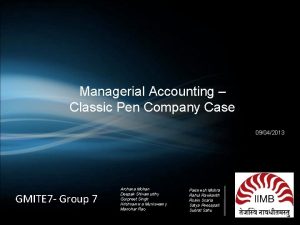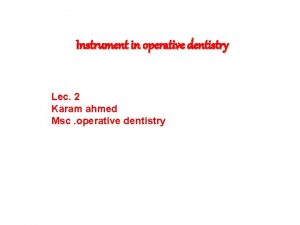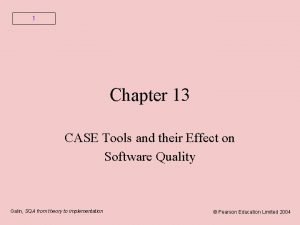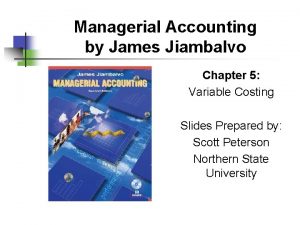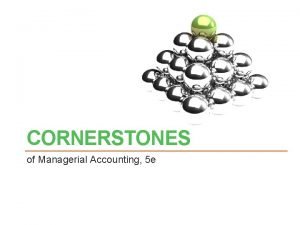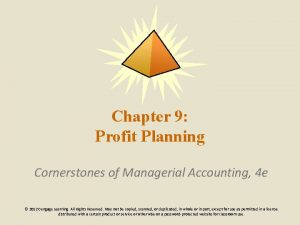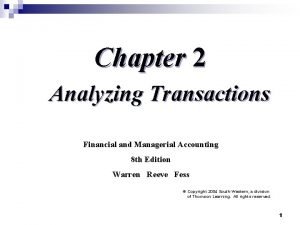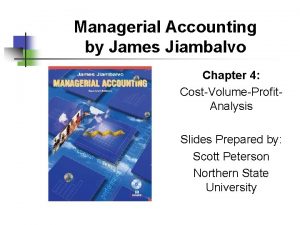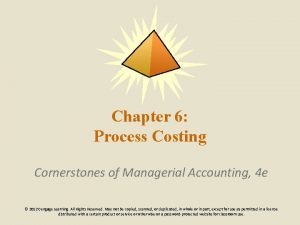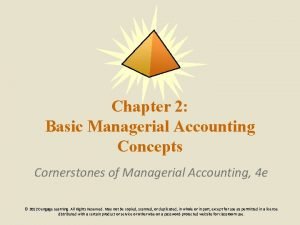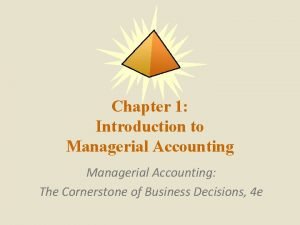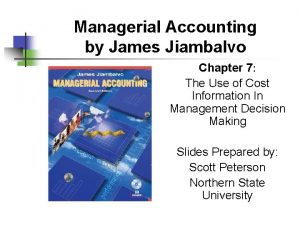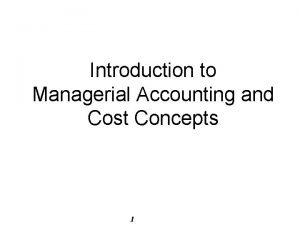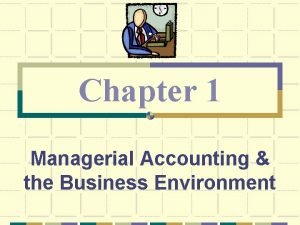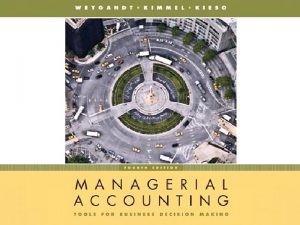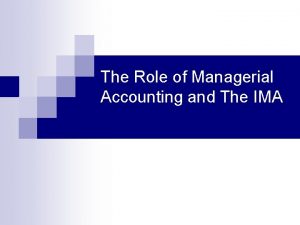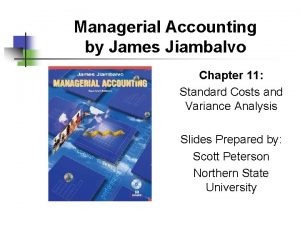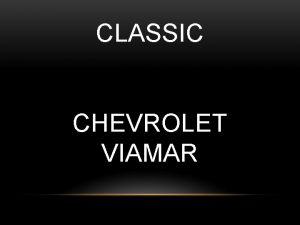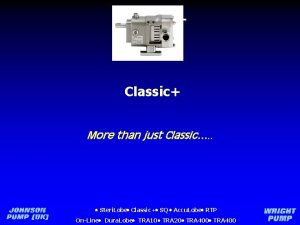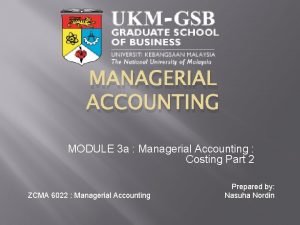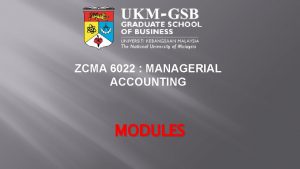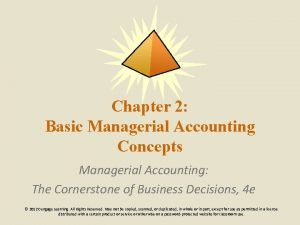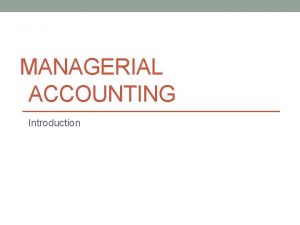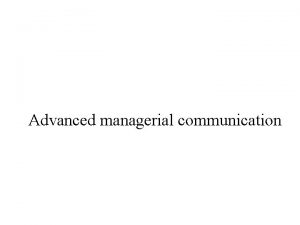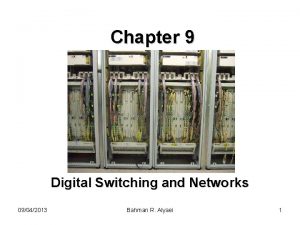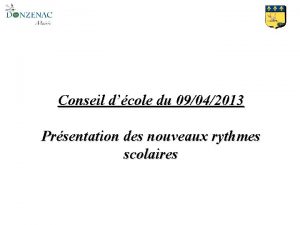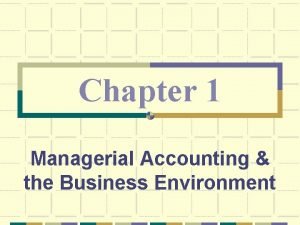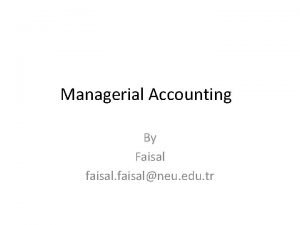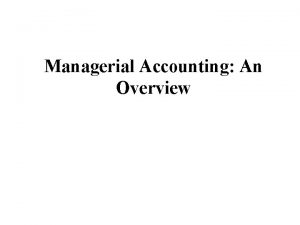Managerial Accounting Classic Pen Company Case 09042013 GMITE






















- Slides: 22

Managerial Accounting – Classic Pen Company Case 09/04/2013 GMITE 7 - Group 7 Archana Mohan Deepak Shivamurthy Gurpreet Singh Krishnamma Muniswamy Manohar Rao Padmesh Mishra Rahul Ravikanth Robin Scaria Satya Peesapati Subrat Sahu

KEY TOPICS • Case Background? -5 min • Key Questions we need to answer – 1 min • Why is Traditional Costing wrong – 2 min • Activity Based Costing – 8 min • Inference/Observations/Recommendations – 8 min • Any questions? 1 -2 min 2 2

CASE BACKGROUND

• What’s the background? • Classic pen company had been the low cost producer of BLUE and BLACK Pens. • Profit margins of over 20% of sales. • Introduced Red pens 5 years back, as technology required was same, and premium of 3% could be charged. • Last year introduced purple pens with premium of 10%. • All pens use same technology and production facility. • Overheads burden rate increased from 200% to 300% with introduction of the new colors.

• Issues highlighted in the case? • Red and Purple pens seems profitable, but overall profitability is down • Is this due to tougher competition or something else? • Purple pens are showing higher margins, so should we introduce more colors? • Are consumers willing to pay more prices for special colors?

KEY QUESTIONS WE NEED TO ANSWER

• Key Questions we need to answer? • By introducing more colors with premium in selling price, profitability is down. Is my cost analysis right? • Calculate the revised product costs for the four pens based on activity information collected. • What actions are stimulated by the ABC product costs?

WHY IS TRADITIONAL COSTING WRONG?

Traditional Income Statement Blue Black Red Purple Total Sales Material Costs $75, 000 $25, 000 $60, 000 $20, 000 $13, 950 $4, 680 $1, 650 $550 $150, 600 $50, 230 Direct Labor $10, 000 $8, 000 $1, 800 $20, 000 $30, 000 $24, 000 $5, 400 $60, 000 Total Operating Income $10, 000 $8, 000 $2, 070 $300 $20, 370 Return on Sales (Contribution Margin) 13. 3% 14. 8% 18. 2% 13. 5% Overhead @300% Why is above costing wrong? • Excerpts from Manufacturing Manager: Ø More change overs with introduction of low volume colored pens Ø Lots of time taken to stop production, empty vats, clean previous color Ø Demanding specifications for Red and Purple, as compared with Blue and Black. Ø Lot of time spent in purchase, scheduling and keeping track of existing, backlogged and future orders. Ø New computer system introduced due to new colors, but cost is attributed to all colored pens equally. 9

Why is above costing wrong? • All indirect expenses are aggregated and allocated to products based on their direct labor content. • Above seems to be the MISTAKE, as there’s a lot of over head expenses introduced with RED and PURPLE pens, but cost is distributed equally against all 4 products @ 300% of the direct labor. Solution? • Need to calculate actual costs and allocate that against each of the products? • Derive next steps based on the new cost analysis? 10

ACTIVITY BASED COSTING

Over Head Expenses Categorized Expense Category Expense Indirect labor $20, 000 Fringe Benefits $16, 000 Computer Systems $10, 000 Machinery Depreciation Machine Maintainence Energy Total $8, 000 $4, 000 $2, 000 $60, 000 Comments 50%: Scheduling and handling production runs 40%: Physical changeover for color change 10%: Maintaining records 40% of labor expenses (direct(20 k) and indirect(20 k)) 80% involved in production run activity 20% keep records for four products Practical capability of 10000 hours Based on volume or machine hours TOTAL OVERHEAD EXPENSES IN CURRENT SETUP • Ok, now we know where are these overhead expenses going • Next step would be to calculate production runs, setup time, administration time for the current volumes of the colored pens, and allocate costs accordingly. 12

Direct cost and activity cost drivers Blue Black Red Purple Total Production Sales Volume (numbers) Unit selling price Direct Material Costs Materials unit cost Direct Labor Direct labor hrs/unit Direct labor unit cost Machine hours/unit Machine hours Parts administration 50000 $1. 5 $25, 000 $0. 50 $10, 000 0. 02 $10 0. 1 5000 1 40000 $1. 5 $20, 000 $0. 50 $8, 000 0. 02 $10 0. 1 4000 1 9000 $1. 6 $4, 680 $0. 52 $1, 800 0. 02 $10 0. 1 900 1 1000 $1. 7 $550 $0. 55 $200 0. 02 $10 0. 1 100000 $50, 230 $20, 000 2000 10000 4 Setup time/run 4 1 6 4 Production quantity/run 1000 800 236. 84211 83. 333333 Total Setup time (hours) 200 50 228 48 526 Production Runs 50 50 38 12 150 • • • Expenses in Green: These are the direct expenses, and increase/decrease in proportion to the volume. Expenses in Red: These are the one that determine overhead expense allocation based on setup time, production runs and parts administration. The ones in black are per unit expenses, and used to calculate total expenses based on volume 13

Activity based costing Blue Number of units Sales Direct Material Costs Direct labor Costs($10 per hour) Overhead Indirect labor- Setup costs (@40%) Indirect labor - Handling Production Runs (@50%) Indirect labor - Maintaining records(@10%) Fringe Benefits (40% of direct) Fringe Benefits (40% of indirect) Computer Systems - Handling Production Runs Computer Systems - Maintaining Records Machinery Depreciation (Proportion to volume) Machine Maintainence (Propotion to volume) Energy (Propotion to volume) Total Overhead Total Variable Costs Total operating Income/ Contribution Return on sales/ Contribution Margin Black Red Purple Total 50000 $75, 000 $25, 000 $10, 000 40000 $60, 000 $20, 000 $8, 000 9000 $13, 950 $4, 680 $1, 800 1000 $1, 650 $550 $200 100000 $150, 600 $50, 230 $20, 000 $3, 041. 83 $760. 46 $3, 467. 68 $730. 04 $8, 000. 0 $3, 333. 33 $2, 533. 33 $800. 00 $10, 000. 0 $500. 00 $4, 000. 00 $2, 750. 06 $500. 00 $3, 200. 00 $1, 837. 52 $500. 00 $720. 00 $2, 600. 41 $500. 00 $812. 02 $2, 000. 0 $8, 000. 00 $2, 666. 67 $2, 026. 67 $640. 00 $8, 000. 00 $500. 0 $2, 000. 00 $4, 000 $3, 200 $720 $8, 000 $2, 000 $1, 600 $360 $4, 000 $1, 000 $800 $180 $2, 000 $23, 791. 89 $18, 397. 97 $13, 608. 09 $4, 202. 05 $60, 000. 00 $58, 791. 89 $46, 397. 97 $20, 088. 09 $4, 952. 05 $130, 230. 00 $16, 208. 11 $13, 602. 03 -$6, 138. 09 -$3, 302. 05 $20, 370. 00 21. 61% 22. 67% -44. 00% -200. 12% 14 13. 53%

Per Unit Contribution Blue Black Red Purple Total variable cost per unit $1. 50 $0. 20 $0. 48 $1. 18 $1. 50 $0. 20 $0. 46 $1. 16 $1. 55 $0. 52 $0. 20 $1. 51 $2. 23 $1. 65 $0. 55 $0. 20 $4. 95 Contribution per unit $0. 32 $0. 34 -$0. 68 -$3. 30 Unit Selling Price Materials Unit Cost Direct Labor/unit Overhead cost/unit Oops!!! Return on Sales (TRADITIONAL METHOD) Return on sales (ACTIVITY BASED COSTING METHOD) Blue Black Red Purple Total 13. 3% 14. 8% 18. 2% 13. 5% 21. 61% 22. 67% -44. 00% -200. 12% 13. 53%

What did I learn? • Contribution margin of Purple Pens is the worst @ -200%. Increasing volumes will hurt more. • Contribution margin of Red Pens is also negative @ -44%. Increasing volumes will hurt more, unless price is adjusted. • Contribution margins of Black and Blue pens stands tall @ 22%, against 13% as suggested by traditional method. • Company is making losses of around $10, 000 by producing Red and Purple Pens, due to huge overhead costs, and incorrect pricing. 16

RECOMMENDATIONS

Option 1 • Option 1 18

Option 2 • Option 2 19

Option 3 • Option 3 20

Our Recommendation • Crux 21

Any Questions?
 Classic pen company case
Classic pen company case Kutsilyo de almasen
Kutsilyo de almasen Inverted pen grasp
Inverted pen grasp Best case worst case average case
Best case worst case average case Classic case tools
Classic case tools Scop of management accounting
Scop of management accounting Managerial accounting chapter 5 solutions
Managerial accounting chapter 5 solutions Managerial accounting chapter 13 solutions
Managerial accounting chapter 13 solutions Planning in managerial accounting
Planning in managerial accounting Managerial accounting chapter 2 solutions
Managerial accounting chapter 2 solutions Jiambalvo managerial accounting
Jiambalvo managerial accounting Process costing problems and solutions doc
Process costing problems and solutions doc Moh accounting
Moh accounting Role of managerial accounting
Role of managerial accounting Management accounting chapter 1
Management accounting chapter 1 Financial and managerial accounting weygandt kimmel kieso
Financial and managerial accounting weygandt kimmel kieso Managerial accounting jiambalvo
Managerial accounting jiambalvo Managerial accounting and cost concepts
Managerial accounting and cost concepts Managerial accounting and the business environment
Managerial accounting and the business environment Chapter 1 managerial accounting
Chapter 1 managerial accounting What is cma
What is cma Managerial accounting concepts and principles
Managerial accounting concepts and principles Managerial accounting james jiambalvo
Managerial accounting james jiambalvo
